中考英语语法专项复习课件:简单句(共43张PPT)
文档属性
| 名称 | 中考英语语法专项复习课件:简单句(共43张PPT) |  | |
| 格式 | zip | ||
| 文件大小 | 594.0KB | ||
| 资源类型 | 教案 | ||
| 版本资源 | 人教新目标(Go for it)版 | ||
| 科目 | 英语 | ||
| 更新时间 | 2018-12-06 08:43:50 | ||
图片预览


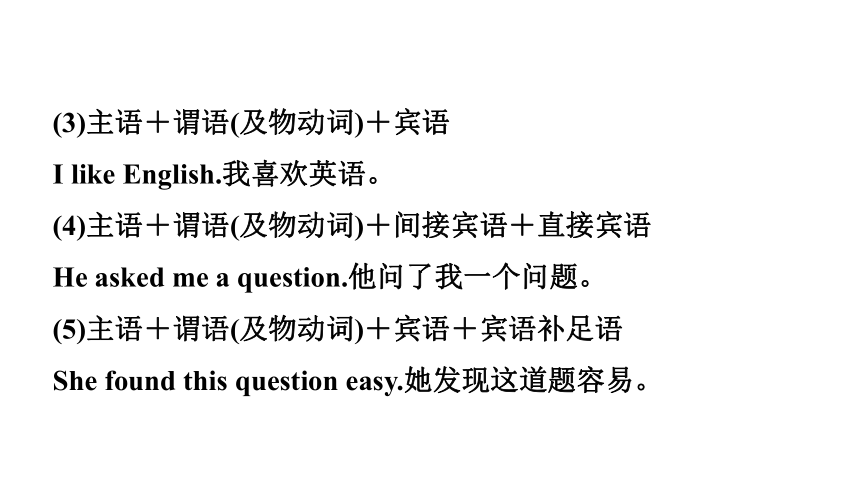
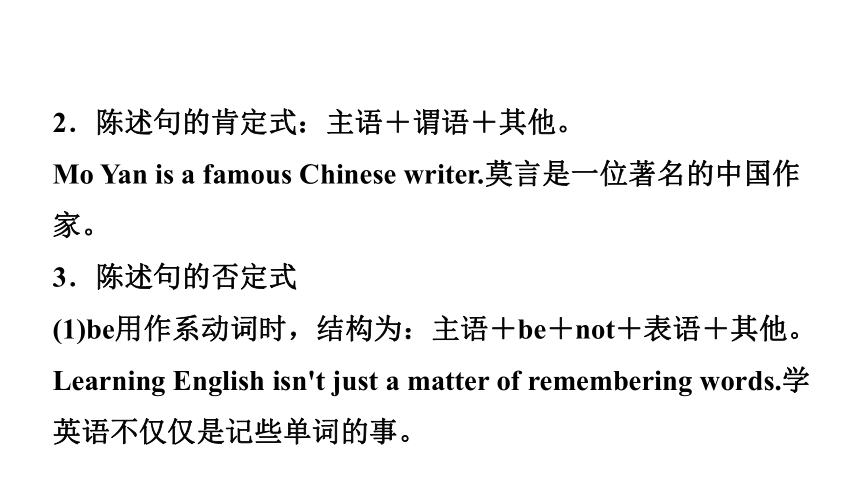
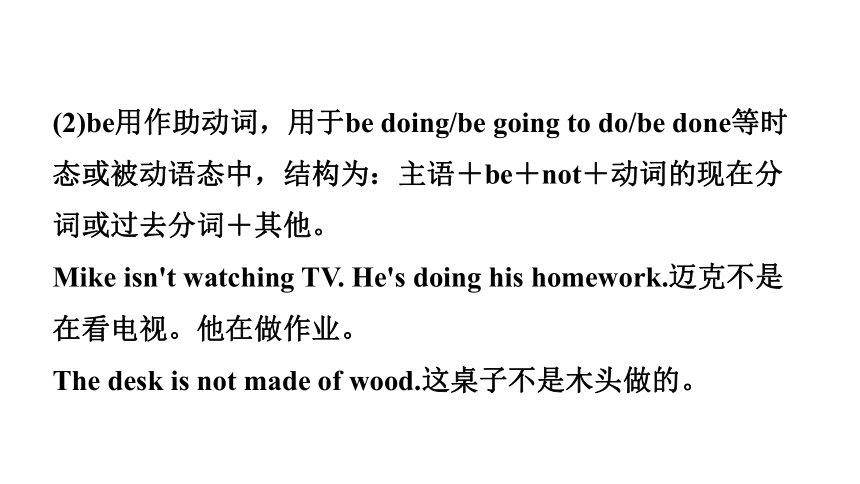


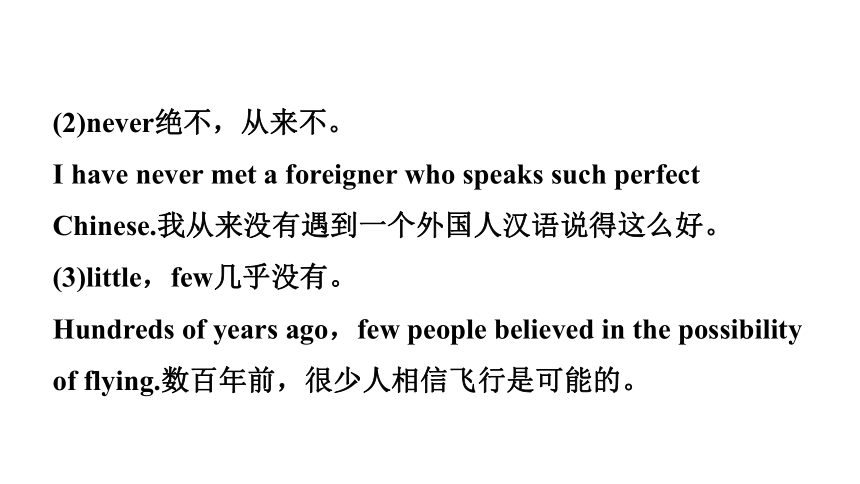
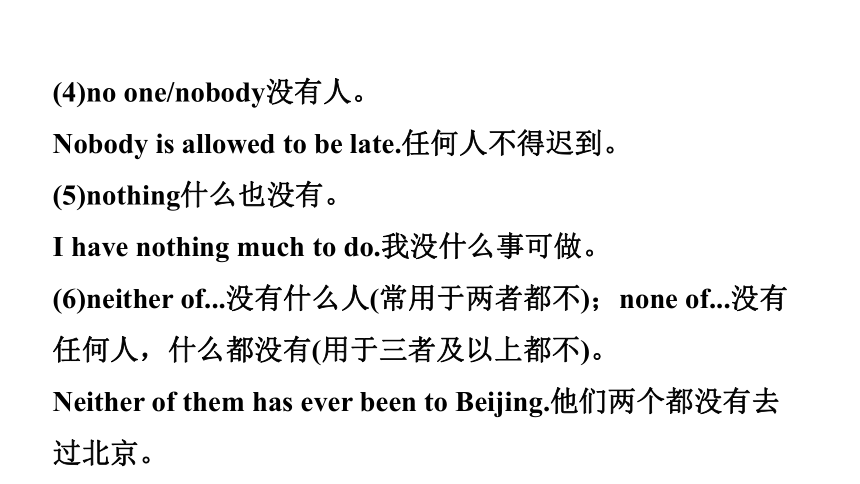
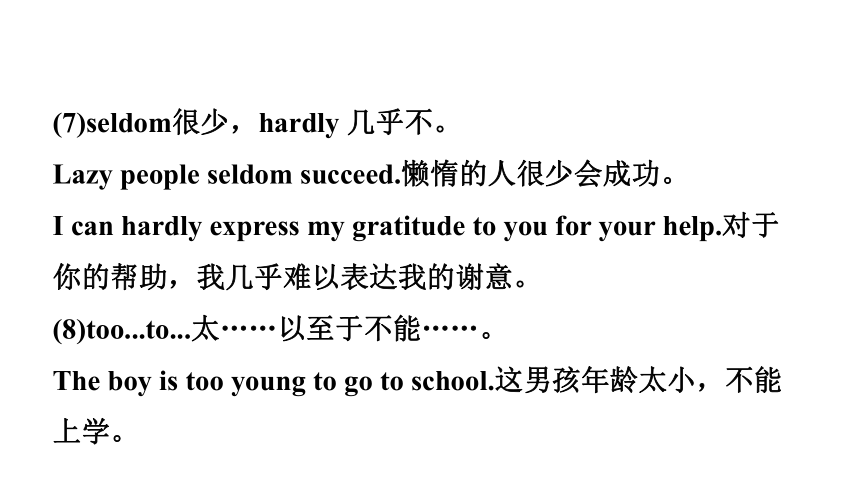
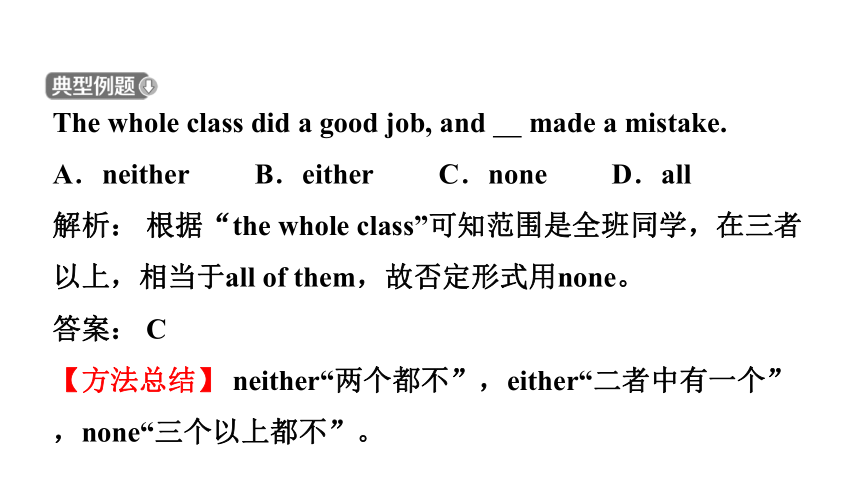
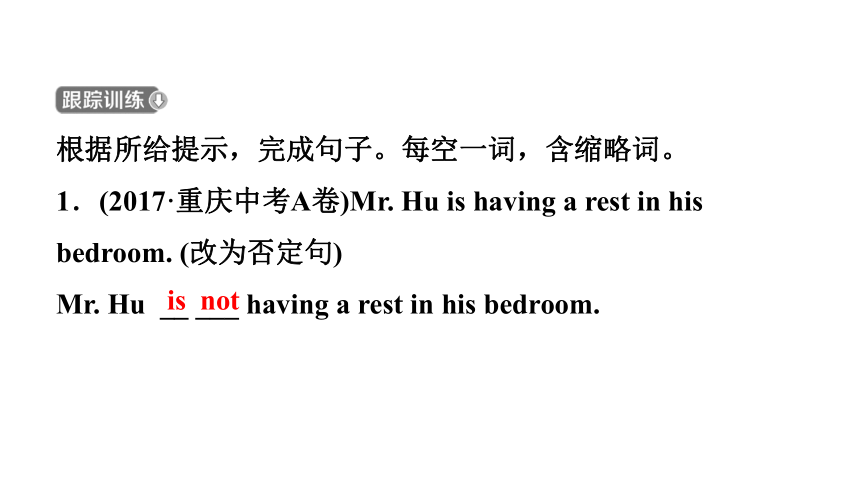
文档简介
语法十二 简单句
考点一 陈述句
1.陈述句的五种基本句型
(1)主语+系动词+表语
I am a student.我是一个学生。
(2)主语+谓语(不及物动词)
The sun rises in the east.太阳从东方升起。
(3)主语+谓语(及物动词)+宾语
I like English.我喜欢英语。
(4)主语+谓语(及物动词)+间接宾语+直接宾语
He asked me a question.他问了我一个问题。
(5)主语+谓语(及物动词)+宾语+宾语补足语
She found this question easy.她发现这道题容易。
2.陈述句的肯定式:主语+谓语+其他。
Mo Yan is a famous Chinese writer.莫言是一位著名的中国作家。
3.陈述句的否定式
(1)be用作系动词时,结构为:主语+be+not+表语+其他。
Learning English isn't just a matter of remembering words.学英语不仅仅是记些单词的事。
(2)be用作助动词,用于be doing/be going to do/be done等时态或被动语态中,结构为:主语+be+not+动词的现在分词或过去分词+其他。
Mike isn't watching TV. He's doing his homework.迈克不是在看电视。他在做作业。
The desk is not made of wood.这桌子不是木头做的。
(3)助动词、情态动词的否定式。
The girl didn't do housework at home.这个女孩在家不做家务。
Fish can't live without water.鱼儿离开水就不能活。
4.除not外,其他否定词也可以构成否定句
(1)用no表示,no=not any/a。
She has no ability in that kind of work.=She doesn't have any ability in that kind of work.她没有做那种工作的能力。
(2)never绝不,从来不。
I have never met a foreigner who speaks such perfect Chinese.我从来没有遇到一个外国人汉语说得这么好。
(3)little,few几乎没有。
Hundreds of years ago,few people believed in the possibility of flying.数百年前,很少人相信飞行是可能的。
(4)no one/nobody没有人。
Nobody is allowed to be late.任何人不得迟到。
(5)nothing什么也没有。
I have nothing much to do.我没什么事可做。
(6)neither of...没有什么人(常用于两者都不);none of...没有任何人,什么都没有(用于三者及以上都不)。
Neither of them has ever been to Beijing.他们两个都没有去过北京。
(7)seldom很少,hardly 几乎不。
Lazy people seldom succeed.懒惰的人很少会成功。
I can hardly express my gratitude to you for your help.对于你的帮助,我几乎难以表达我的谢意。
(8)too...to...太……以至于不能……。
The boy is too young to go to school.这男孩年龄太小,不能上学。
The whole class did a good job, and made a mistake.
A.neither B.either C.none D.all
解析: 根据“the whole class”可知范围是全班同学,在三者以上,相当于all of them,故否定形式用none。
答案: C
【方法总结】 neither“两个都不”,either“二者中有一个”,none“三个以上都不”。
根据所给提示,完成句子。每空一词,含缩略词。
1.(2017·重庆中考A卷)Mr. Hu is having a rest in his bedroom. (改为否定句)
Mr. Hu __ ___ having a rest in his bedroom.
is
not
2.(2018·上海中考)John went to church with his brother last Sunday morning.(改为否定句)
John ______ ___ to church with his brother last Sunday morning.
3.(2018·贵州黔南中考)Tom does morning exercise every day.(改为否定句)
Tom _______ ___ morning exercise every day.
didn't
go
doesn't
do
4.(2017·贵州安顺中考)Ben has finished the project on
reusing natural resources.(改为否定句)
Ben ______ _______ the project on reusing natural resources.
5.(2017·重庆中考B卷)Mark is watching TV now. (改为否
定句)
Mark ____ ________TV now.
hasn't
finished
isn't
watching
考点二 疑问句
1.一般疑问句是询问一件事或一个情况是否属实的疑问
句,常用yes, no来回答,但在口语中有时也用yes, no之外
的词回答。口语中若无特殊含义,句末用升调。
2.一般疑问句也可用其他表示肯定或否定的词回答,如:
certainly, surely, of course, I think so, all right, certainly not,
not at all, never, sorry, not yet, I'm afraid not等。
3.特殊疑问句的基本结构是“疑问词+一般疑问句”。常见的特殊疑问词是指wh?开头外加能与之相结伴而行的名词和how以及它的形容词。英语中常用的疑问词有what, where, which, who, whom, whose, how, how many, how old, how much等。
4.选择疑问句的前部分用升调,后部分用降调。这种疑问
句有两种形式:一种是以一般疑问句为基础,另一种是以
特殊疑问句为基础。or连接的两个并列成分可以是状语、
宾语、表语、谓语或是两个句子等。
5.反意疑问句的结构:(1)肯定的陈述句+否定的简短问
句?(2)否定的陈述句+肯定的简短问句?
6.反意疑问句的用法注意
(1)反意疑问句前后两部分必须遵循的原则是“三同一反”,即:
人称相同,动词相同,时态相同,前肯后否,前否后肯。
(2)对反意疑问句的回答,不管问题的提法如何,若事实是肯
定的,就要用yes回答;事实是否定的,就要用no回答。注意
在“前否后肯”的反意疑问句的答语中,yes意为“不”,no意为
“是”。
(3)如果陈述句中含有表示否定意义的词,如never, hardly, few, little等,在构成反意疑问句时,附加疑问句部分需用肯定式。
(4)若陈述句部分含有否定前缀的词,如:unhappy, impossible, untrue, dislike 等,应把陈述句看作肯定句,构成反意疑问句时,附加疑问句用否定式。
Nothing has been considered about this meeting, ?
A.has it B.haven't they
C.have they D.hasn't it
解析: 陈述部分中,主语是nothing, 附加提问时人称代词用it,并且该句作肯定句看待。
答案: D
【方法总结】 陈述句的主语中是everything, anything, something, nothing附加问句的主语用it。
1.(2018·甘肃天水中考)—How often do your teachers have
a meeting?
—___.
A.For one week B.One week ago
C.In one week D.Once a week
D
2.(2018·黑龙江绥化中考改编)—___ do you like wolf warriors Ⅱ?
—Because it's exciting.
A.Why B.What
C.How D.Where
A
3.(2018·贵州黔南中考)He has few friends in his new school,
___?
A.hasn't he B.does he
C.is he D.doesn't he
B
4.(2018· 贵州安顺中考)—There is little money for Mr.
Lee to buy a ticket for today's show,___?
—Exactly!
A.are there B.isn't there
C.aren't there D.is there
D
5.(2018·吉林长春中考)—Lucy, do you want to join the
art club or the chess club?
—___. I like drawing pictures.
A.Yes, I do B.The art club
C.No, I don't D.The chess club
B
考点三 祈使句和感叹句
1.祈使句与简单句、复合句之间的转换
(1)“Let's+动词原形+其他。”可转换为“Shall we+动词原形+其他?”
Let's go fishing this afternoon.=Shall we go fishing this afternoon?
(2)“祈使句+ and/then/or+简单句”可转换为含if引导的条件状语从句。
Use your head, then you'll find a way.=If you use your head, you'll find a way.
Hurry up, or we'll be late.= If we don't hurry, we'll be late.
2.祈使句的应答语
(1)Let's开头的祈使句,其答语常用Good idea./OK./Yes, I'd love to.等。
—Let's go to the park.让我们去公园吧。
—Good idea.好主意。
(2)其他肯定祈使句的应答语为Yes, I will. 否定祈使句的应答语为Sorry/No, I won't (do it again).
—It's going to rain. Remember to take an umbrella with you.
—Thanks, I will.
——就要下雨了。记着带上雨伞。
——谢谢,我会的。
3.祈使句之后的附加疑问句
(1)一般祈使句之后, 附加疑问句常用will you? 或won't you?
(2)以let's 开头的祈使句之后, 附加疑问句常用shall we?
4.what引导的感叹句
(1)What+a(an)+形容词+可数名词的单数形式+主语+谓语!
What a nice present it is! 它是一件多么好的礼物啊!
What an interesting book it is! 它是一本多么有趣的书啊!
(2)What+形容词+可数名词的复数形式+主语+谓语!
What beautiful flowers they are! 多么漂亮的花啊!
(3)What+形容词+不可数名词+主语+谓语!
What fine weather it is today! 今天天气多好啊!
What important news it is! 多重要的新闻啊!
5. how引导的感叹句
(1)How+形容词或副词+主语+谓语!
How careful she is! 她多么细心啊!
How fast he runs! 他跑得多快啊!
(2)How+形容词+a/an+可数名词的单数形式+主语+
谓语!
How beautiful a girl she is! 她是个多么漂亮的姑娘啊!
(3)How+主语+谓语!
How time flies!时间过得真快呀!
1.—Look at the sign, what does it mean?
—It means “ ”.
A.Don't talking B.No talking
C.Not talk D.Not talking
解析: 表示“不要说话”可以使用Don't talk. 或No talking.两种形式,因此,答案选择B项。
答案: B
【方法总结】 否定结构主要有“Don't+动词原形+其他”和“No+名词或动名词”两种形式。
2.—Dad, do you like my picture?
— ! It's the nicest one I've ever seen!
A.What beautiful B.How careful
C.How wonderful D.What wonderful picture
解析: 对图画赞叹时不能用形容词careful,排除B项。对形容词感叹时用how,排除A项。picture为可数名词,单数前应用不定冠词,排除D项。
答案: C
【方法总结】 在做感叹句的题目时,分清可数名词与不可数名词、名词单数和复数很重要。
1.(2018·黑龙江龙东中考改编)Tom, ___ the umbrella with you. Look at the clouds, it's going to rain!
A.taking B.takes
C.take D.to take
C
2.(2018·吉林中考改编)Please ___here earlier!We don't want to miss the last bus to the library.
A.arrive B.to arrive
C.arriving D.arrived
A
3.(2017·四川眉山中考改编)—Listen!Someone is playing violin.
—Wow! ___ beautiful music! I like it very much.
A.What B.How a
C.What the D.How
A
4.(2018·吉林长春中考)___ clever dog Lucky is! It can
understand Mr. Smith's orders.
A.What B.What a C.How D.How a
5.(2018·青海中考改编)___ wonderful the sitcom is!
We all like it.
A.What B.How C.What a D.How a
B
B
考点一 陈述句
1.陈述句的五种基本句型
(1)主语+系动词+表语
I am a student.我是一个学生。
(2)主语+谓语(不及物动词)
The sun rises in the east.太阳从东方升起。
(3)主语+谓语(及物动词)+宾语
I like English.我喜欢英语。
(4)主语+谓语(及物动词)+间接宾语+直接宾语
He asked me a question.他问了我一个问题。
(5)主语+谓语(及物动词)+宾语+宾语补足语
She found this question easy.她发现这道题容易。
2.陈述句的肯定式:主语+谓语+其他。
Mo Yan is a famous Chinese writer.莫言是一位著名的中国作家。
3.陈述句的否定式
(1)be用作系动词时,结构为:主语+be+not+表语+其他。
Learning English isn't just a matter of remembering words.学英语不仅仅是记些单词的事。
(2)be用作助动词,用于be doing/be going to do/be done等时态或被动语态中,结构为:主语+be+not+动词的现在分词或过去分词+其他。
Mike isn't watching TV. He's doing his homework.迈克不是在看电视。他在做作业。
The desk is not made of wood.这桌子不是木头做的。
(3)助动词、情态动词的否定式。
The girl didn't do housework at home.这个女孩在家不做家务。
Fish can't live without water.鱼儿离开水就不能活。
4.除not外,其他否定词也可以构成否定句
(1)用no表示,no=not any/a。
She has no ability in that kind of work.=She doesn't have any ability in that kind of work.她没有做那种工作的能力。
(2)never绝不,从来不。
I have never met a foreigner who speaks such perfect Chinese.我从来没有遇到一个外国人汉语说得这么好。
(3)little,few几乎没有。
Hundreds of years ago,few people believed in the possibility of flying.数百年前,很少人相信飞行是可能的。
(4)no one/nobody没有人。
Nobody is allowed to be late.任何人不得迟到。
(5)nothing什么也没有。
I have nothing much to do.我没什么事可做。
(6)neither of...没有什么人(常用于两者都不);none of...没有任何人,什么都没有(用于三者及以上都不)。
Neither of them has ever been to Beijing.他们两个都没有去过北京。
(7)seldom很少,hardly 几乎不。
Lazy people seldom succeed.懒惰的人很少会成功。
I can hardly express my gratitude to you for your help.对于你的帮助,我几乎难以表达我的谢意。
(8)too...to...太……以至于不能……。
The boy is too young to go to school.这男孩年龄太小,不能上学。
The whole class did a good job, and made a mistake.
A.neither B.either C.none D.all
解析: 根据“the whole class”可知范围是全班同学,在三者以上,相当于all of them,故否定形式用none。
答案: C
【方法总结】 neither“两个都不”,either“二者中有一个”,none“三个以上都不”。
根据所给提示,完成句子。每空一词,含缩略词。
1.(2017·重庆中考A卷)Mr. Hu is having a rest in his bedroom. (改为否定句)
Mr. Hu __ ___ having a rest in his bedroom.
is
not
2.(2018·上海中考)John went to church with his brother last Sunday morning.(改为否定句)
John ______ ___ to church with his brother last Sunday morning.
3.(2018·贵州黔南中考)Tom does morning exercise every day.(改为否定句)
Tom _______ ___ morning exercise every day.
didn't
go
doesn't
do
4.(2017·贵州安顺中考)Ben has finished the project on
reusing natural resources.(改为否定句)
Ben ______ _______ the project on reusing natural resources.
5.(2017·重庆中考B卷)Mark is watching TV now. (改为否
定句)
Mark ____ ________TV now.
hasn't
finished
isn't
watching
考点二 疑问句
1.一般疑问句是询问一件事或一个情况是否属实的疑问
句,常用yes, no来回答,但在口语中有时也用yes, no之外
的词回答。口语中若无特殊含义,句末用升调。
2.一般疑问句也可用其他表示肯定或否定的词回答,如:
certainly, surely, of course, I think so, all right, certainly not,
not at all, never, sorry, not yet, I'm afraid not等。
3.特殊疑问句的基本结构是“疑问词+一般疑问句”。常见的特殊疑问词是指wh?开头外加能与之相结伴而行的名词和how以及它的形容词。英语中常用的疑问词有what, where, which, who, whom, whose, how, how many, how old, how much等。
4.选择疑问句的前部分用升调,后部分用降调。这种疑问
句有两种形式:一种是以一般疑问句为基础,另一种是以
特殊疑问句为基础。or连接的两个并列成分可以是状语、
宾语、表语、谓语或是两个句子等。
5.反意疑问句的结构:(1)肯定的陈述句+否定的简短问
句?(2)否定的陈述句+肯定的简短问句?
6.反意疑问句的用法注意
(1)反意疑问句前后两部分必须遵循的原则是“三同一反”,即:
人称相同,动词相同,时态相同,前肯后否,前否后肯。
(2)对反意疑问句的回答,不管问题的提法如何,若事实是肯
定的,就要用yes回答;事实是否定的,就要用no回答。注意
在“前否后肯”的反意疑问句的答语中,yes意为“不”,no意为
“是”。
(3)如果陈述句中含有表示否定意义的词,如never, hardly, few, little等,在构成反意疑问句时,附加疑问句部分需用肯定式。
(4)若陈述句部分含有否定前缀的词,如:unhappy, impossible, untrue, dislike 等,应把陈述句看作肯定句,构成反意疑问句时,附加疑问句用否定式。
Nothing has been considered about this meeting, ?
A.has it B.haven't they
C.have they D.hasn't it
解析: 陈述部分中,主语是nothing, 附加提问时人称代词用it,并且该句作肯定句看待。
答案: D
【方法总结】 陈述句的主语中是everything, anything, something, nothing附加问句的主语用it。
1.(2018·甘肃天水中考)—How often do your teachers have
a meeting?
—___.
A.For one week B.One week ago
C.In one week D.Once a week
D
2.(2018·黑龙江绥化中考改编)—___ do you like wolf warriors Ⅱ?
—Because it's exciting.
A.Why B.What
C.How D.Where
A
3.(2018·贵州黔南中考)He has few friends in his new school,
___?
A.hasn't he B.does he
C.is he D.doesn't he
B
4.(2018· 贵州安顺中考)—There is little money for Mr.
Lee to buy a ticket for today's show,___?
—Exactly!
A.are there B.isn't there
C.aren't there D.is there
D
5.(2018·吉林长春中考)—Lucy, do you want to join the
art club or the chess club?
—___. I like drawing pictures.
A.Yes, I do B.The art club
C.No, I don't D.The chess club
B
考点三 祈使句和感叹句
1.祈使句与简单句、复合句之间的转换
(1)“Let's+动词原形+其他。”可转换为“Shall we+动词原形+其他?”
Let's go fishing this afternoon.=Shall we go fishing this afternoon?
(2)“祈使句+ and/then/or+简单句”可转换为含if引导的条件状语从句。
Use your head, then you'll find a way.=If you use your head, you'll find a way.
Hurry up, or we'll be late.= If we don't hurry, we'll be late.
2.祈使句的应答语
(1)Let's开头的祈使句,其答语常用Good idea./OK./Yes, I'd love to.等。
—Let's go to the park.让我们去公园吧。
—Good idea.好主意。
(2)其他肯定祈使句的应答语为Yes, I will. 否定祈使句的应答语为Sorry/No, I won't (do it again).
—It's going to rain. Remember to take an umbrella with you.
—Thanks, I will.
——就要下雨了。记着带上雨伞。
——谢谢,我会的。
3.祈使句之后的附加疑问句
(1)一般祈使句之后, 附加疑问句常用will you? 或won't you?
(2)以let's 开头的祈使句之后, 附加疑问句常用shall we?
4.what引导的感叹句
(1)What+a(an)+形容词+可数名词的单数形式+主语+谓语!
What a nice present it is! 它是一件多么好的礼物啊!
What an interesting book it is! 它是一本多么有趣的书啊!
(2)What+形容词+可数名词的复数形式+主语+谓语!
What beautiful flowers they are! 多么漂亮的花啊!
(3)What+形容词+不可数名词+主语+谓语!
What fine weather it is today! 今天天气多好啊!
What important news it is! 多重要的新闻啊!
5. how引导的感叹句
(1)How+形容词或副词+主语+谓语!
How careful she is! 她多么细心啊!
How fast he runs! 他跑得多快啊!
(2)How+形容词+a/an+可数名词的单数形式+主语+
谓语!
How beautiful a girl she is! 她是个多么漂亮的姑娘啊!
(3)How+主语+谓语!
How time flies!时间过得真快呀!
1.—Look at the sign, what does it mean?
—It means “ ”.
A.Don't talking B.No talking
C.Not talk D.Not talking
解析: 表示“不要说话”可以使用Don't talk. 或No talking.两种形式,因此,答案选择B项。
答案: B
【方法总结】 否定结构主要有“Don't+动词原形+其他”和“No+名词或动名词”两种形式。
2.—Dad, do you like my picture?
— ! It's the nicest one I've ever seen!
A.What beautiful B.How careful
C.How wonderful D.What wonderful picture
解析: 对图画赞叹时不能用形容词careful,排除B项。对形容词感叹时用how,排除A项。picture为可数名词,单数前应用不定冠词,排除D项。
答案: C
【方法总结】 在做感叹句的题目时,分清可数名词与不可数名词、名词单数和复数很重要。
1.(2018·黑龙江龙东中考改编)Tom, ___ the umbrella with you. Look at the clouds, it's going to rain!
A.taking B.takes
C.take D.to take
C
2.(2018·吉林中考改编)Please ___here earlier!We don't want to miss the last bus to the library.
A.arrive B.to arrive
C.arriving D.arrived
A
3.(2017·四川眉山中考改编)—Listen!Someone is playing violin.
—Wow! ___ beautiful music! I like it very much.
A.What B.How a
C.What the D.How
A
4.(2018·吉林长春中考)___ clever dog Lucky is! It can
understand Mr. Smith's orders.
A.What B.What a C.How D.How a
5.(2018·青海中考改编)___ wonderful the sitcom is!
We all like it.
A.What B.How C.What a D.How a
B
B
同课章节目录
- 词法
- 名词
- 动词和动词短语
- 动词语态
- 动词时态
- 助动词和情态动词
- 非谓语动词
- 冠词
- 代词
- 数词和量词
- 形容词副词及其比较等级
- 介词和介词短语
- 连词和感叹词
- 构词法
- 相似、相近词比较
- 句法
- 陈述句
- 一般疑问句和否定疑问句
- 特殊疑问句及选择疑问句
- 反意疑问句
- 存在句(There be句型)
- 宾语从句
- 定语从句
- 状语从句
- 主谓一致问题
- 简单句
- 并列句
- 复合句
- 主谓一致
- 主、表语从句
- 名词性从句
- 直接引语和间接引语
- 虚拟语气
- 感叹句
- 强调句
- 倒装句
- 祈使句
- 句子的成分
- 句子的分类
- 题型专区
- 单项选择部分
- 易错题
- 完形填空
- 阅读理解
- 词汇练习
- 听说训练
- 句型转换
- 补全对话
- 短文改错
- 翻译
- 书面表达
- 任务型阅读
- 语法填空
- 其他资料
